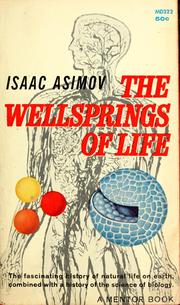Check nearby libraries
Buy this book

This is the middle of a set of three biochemistry books Asimov wrote in the 1950’s and 1960’s which form a progressive examination of the field. The Wellsprings of Life is divided into four sections.
The first is a general overview of life and its possible origins. Asimov spends a fair amount of time discussing the history of the struggles within biology and geology which lead to the modern world-view centered on Darwinian evolution, including a literal interpretation of the early chapters of Genesis, the issue of spontaneous generation, and the development of evolution by natural selection by Darwin and Wallace. Himself an ardent Darwinist, Asimov pulls no punches over his feelings regarding a literal reading of Genesis being used as the basis for thinking about the origin of life on earth, although he is sensitive to avoid dismissing the Bible’s religious value. The religious issues are, nonetheless, at the core of the first section, as generation after generation of scientist has to struggle against religious opposition to scientific progress, and Asimov tells this story well and with dramatic flair. (Some of his favorite stories about the history of science and the ideal ethics of the scientist are from this period of the history of biology: Darwin and Wallace, and the rediscovery of Mendel’s work.)
The second section is a general overview of the organization of life on the planet into phyla, subphyla, and so on, and a brief overview of cytology. The third then delves into the molecule and covers basic biochemistry, focusing on proteins, enzymes, and the DNA that makes them. The book ends with a chapter on the modern spontaneous generation and how science currently feels life on the Earth may have originated.
This is, in fact, an excellent volume which manages to cover a broad amount of material in a fairly short space. Each section is thorough, straightforward, and simple to understand, and the sections are interwoven well to create a coherent, logical whole. It is also a book which provides a good broad understanding of Asimov’s own philosophy regarding science, rationalism, religion, and ethics, and so is a good introduction to some of the author’s own approaches to life, as well.
Check nearby libraries
Buy this book

Previews available in: English
Subjects
Science, Biology, Life (Biology), Evolution, Evolution (Biology)Showing 3 featured editions. View all 21 editions?
| Edition | Availability |
|---|---|
| 1 |
aaaa
Libraries near you:
WorldCat
|
| 2 |
cccc
Libraries near you:
WorldCat
|
| 3 |
eeee
Libraries near you:
WorldCat
|
Book Details
Published in
New York]
Edition Notes
The Physical Object
ID Numbers
Community Reviews (0)
Feedback?History
- Created August 10, 2011
- 6 revisions
Wikipedia citation
×CloseCopy and paste this code into your Wikipedia page. Need help?
| March 15, 2020 | Edited by Lisa | Edited without comment. |
| July 22, 2019 | Edited by MARC Bot | remove fake subjects |
| February 22, 2019 | Edited by sherryjaye | Title case |
| November 5, 2011 | Edited by WorkBot | merge works |
| August 10, 2011 | Created by ImportBot | Imported from Internet Archive item record. |
















